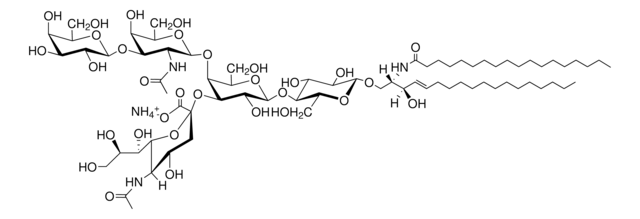G7641
Monosialoganglioside GM1 from bovine brain
≥95% (TLC), lyophilized powder, sialoglycolipid
Synonym(s):
Ganglioside GM1, monosialo
About This Item
Recommended Products
product name
Monosialoganglioside GM1 from bovine brain, ≥95%, lyophilized powder
Quality Level
Assay
≥95%
form
lyophilized powder
storage temp.
−20°C
SMILES string
CCCCCCCCCCCCCCCCCCCC(=O)N[C@H](CO[C@@H]1O[C@H](CO)[C@@H](O[C@@H]2O[C@H](CO)[C@H](O[C@@H]3O[C@H](CO)[C@H](O)[C@H](O[C@@H]4O[C@H](CO)[C@H](O)[C@H](O)[C@H]4O)[C@H]3NC(C)=O)[C@H](O[C@@]5(C[C@H](O)[C@@H](NC(C)=O)[C@@H](O5)[C@H](O)[C@H](O)CO)C(O)=O)[C@H]2O)[C@H](O)[C@H]1O)[C@@H](O)\C=C\CCCCCCCCCCCCCCC
InChI
1S/C73H131N3O31/c1-5-7-9-11-13-15-17-19-20-22-24-26-28-30-32-34-52(86)76-44(45(83)33-31-29-27-25-23-21-18-16-14-12-10-8-6-2)40-99-69-61(93)59(91)63(50(38-79)102-69)104-71-62(94)67(98-41-47(85)55(87)66-53(74-42(3)81)46(84)35-73(97,107-66)72(95)96)64(51(39-80)103-71)105-68-54(75-43(4)82)65(57(89)49(37-78)100-68)106-70-60(92)58(90)56(88)48(36-77)101-70/h31,33,44-51,53-71,77-80,83-85,87-94,97H,5-30,32,34-41H2,1-4H3,(H,74,81)(H,75,82)(H,76,86)(H,95,96)/b33-31+/t44?,45?,46-,47?,48+,49+,50+,51+,53+,54+,55?,56-,57-,58-,59+,60+,61+,62+,63+,64-,65+,66+,67+,68-,69+,70-,71-,73-/m0/s1
InChI key
CNLVNZJJSHZYAS-ALSOZVJRSA-N
Looking for similar products? Visit Product Comparison Guide
Amino Acid Sequence
General description
Application
- in GM1 capture enzyme-linked immunosorbent assay (ELISA)
- for the quantification of cholera toxin B subunit (CTB)-p277 protein accumulation
- for Escherichia coli heat-labile enterotoxin (LT-B) detection
- to determine the affinity of the GM1-ganglioside receptor for the plant-derived Escherichia coli heat-labile toxin LTK63 protein
Biochem/physiol Actions
Storage Class Code
11 - Combustible Solids
WGK
WGK 3
Flash Point(F)
Not applicable
Flash Point(C)
Not applicable
Personal Protective Equipment
Certificates of Analysis (COA)
Search for Certificates of Analysis (COA) by entering the products Lot/Batch Number. Lot and Batch Numbers can be found on a product’s label following the words ‘Lot’ or ‘Batch’.
Already Own This Product?
Find documentation for the products that you have recently purchased in the Document Library.
Our team of scientists has experience in all areas of research including Life Science, Material Science, Chemical Synthesis, Chromatography, Analytical and many others.
Contact Technical Service






